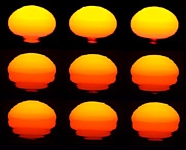10) The Sun, the Moon, Venus, Mercury or any daytime/nighttime star close to the horizon appear "distorted."
 To see this, it doesn't take much follow-up, but rather to notice what happens to any of these objects when they are seen near the horizon. When the Sun is about to "set," it may appear blurry, orange, or oval-shaped; the Moon may appear orange and strange. While this does not occur in the same way with any distant daytime object (e.g. a mountain, a forest), it is noticeable that any object on the horizon will appear "paler" or "hazier" than those close by. While this does not immediately indicate the presence of an atmosphere or the curvature of the Earth, it does give a clue that "something" invariably affects the vision of a distant object, due to a property of the observation site and not of the observed object itself.
To see this, it doesn't take much follow-up, but rather to notice what happens to any of these objects when they are seen near the horizon. When the Sun is about to "set," it may appear blurry, orange, or oval-shaped; the Moon may appear orange and strange. While this does not occur in the same way with any distant daytime object (e.g. a mountain, a forest), it is noticeable that any object on the horizon will appear "paler" or "hazier" than those close by. While this does not immediately indicate the presence of an atmosphere or the curvature of the Earth, it does give a clue that "something" invariably affects the vision of a distant object, due to a property of the observation site and not of the observed object itself.
Preliminary conclusion: Knowing the Earth's atmosphere. While this determination is difficult by mere observation, everyday life offers several analogies to atmospheric interference on distant objects. Just as the presence of more layers of atmospheric gas hinders the vision of low objects on the horizon, when observing any object underwater it will always look more blurry, because the masses of water cloud and interfere with the passage of light.

